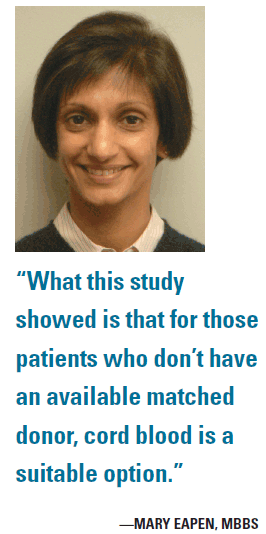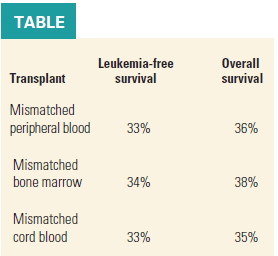Mismatched cord blood stem cells meet need for urgent Rx in acute leukemia
SAN FRANCISCO-Mismatched cord blood can be a suitable alternative for stem cell transplants for patients with acute leukemia, especially in emergency situations, according to research presented at ASH 2008.
SAN FRANCISCO-Mismatched cord blood can be a suitable alternative for stem cell transplants for patients with acute leukemia, especially in emergency situations, according to research presented at ASH 2008.

The study of bone marrow stem cell transplants in 1,240 adults with acute leukemia revealed that rates of transplant-related deaths, leukemia-free survival, and overall survival were similar for mismatched peripheral blood, bone marrow, and cord blood transplants. Among patients with cord blood transplants, there was also less chronic graft -vs-host disease than from mismatched peripheral blood and bone marrow transplants (abstract 151).
“The chance of finding a matched donor among Caucasians is just 50%, if there’s no matched sibling donor, and the rates are even lower for minorities. For instance, the rate of matched unrelated donors among African Americans is 17%,” said lead researcher Mary Eapen, MBBS, an associate professor of pediatrics at the Medical College of Wisconsin in Milwaukee. “What this study showed is that for those patients who don’t have an available matched donor, cord blood is a suitable option.”
The study analyzed the outcomes of 707 patients with acute myeloid leukemia and 533 patients with acute lymphocytic leukemia who received stem cell transplants from 2002 to 2006, using registry data from the National Marrow Donor Program. The study evaluated the efficacy of three types of stem cell sources: bone marrow, peripheral blood, and cord blood.

Among patients who received a bone marrow stem cell transplant, 243 were matched at eight out of eight possible HLA loci and 111 were matched at seven HLA loci. In those receiving a peripheral blood stem cell transplant, 518 were matched at eight HLA loci and 210 at seven HLA loci. For those receiving cord blood transplants, 28 were matched at five or six HLA loci and 110 at four HLA loci.
Newsletter
Stay up to date on recent advances in the multidisciplinary approach to cancer.